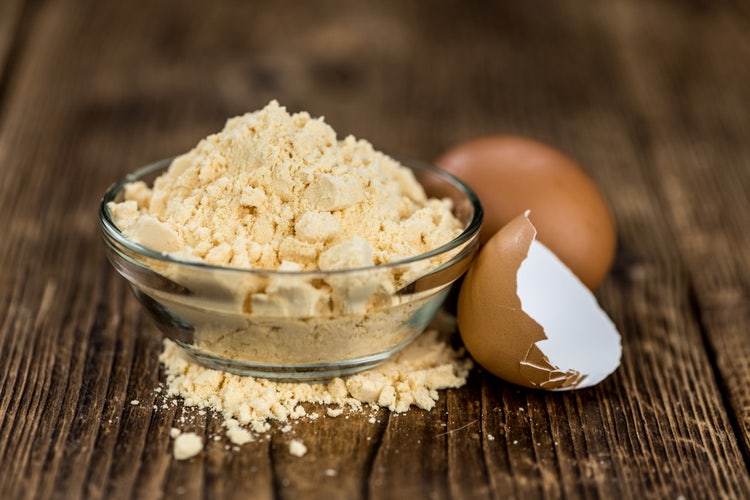
At a glance
The baking industry is increasingly exploring egg replacements to reduce costs and improve supply chain resilience.
• Egg substitutes in baking: Rising egg prices (up 53%) and supply instability are driving demand for plant-based egg alternatives
• Functional replication: Egg replacements must match emulsification, foaming and leavening properties — achieved through multifunctional ingredients like starches, proteins and hydrocolloids
• Clean label and allergen-free trends: 69% of consumers prefer clean label baking ingredients; 36% seek egg-free baking solutions
• Cost and sustainability benefits: Up to 10% cost savings, longer shelf life and improved nutrition with vegan egg substitutes
• Ingredion’s egg replacement systems: Solutions like SIMPLISTICA BK 7224 enable partial or full egg replacement in cakes and gluten-free bread
The price of eggs for consumers has surged 53% over the past year, including a 15.2% increase between January and February 2025.1 This rise is largely driven by avian flu outbreaks globally, causing significant supply shortages and cost increases for food manufacturers. Additionally, many brands are transitioning to cage-free eggs to meet sustainability and environmental goals, further impacting costs. Meanwhile, consumers are seeking more affordable options without compromising on quality.
So, how do you navigate this volatile market? One approach is by using egg replacements in baking formulations. With more options than ever, manufacturers can cut costs and still achieve customer-preferred texture and structure in bakery products. Discover how these innovative egg replacements can help you stay ahead, even with periodic supply chain uncertainties.
What role do eggs play in bakery?
Eggs play a crucial role in baking, contributing to structure, moisture, flavor and richness. As you consider replacing or reducing eggs in baking formulations, it's important to select alternatives that perform the same functions as eggs would, including:
- Emulsification: The lecithin in egg yolks serves as an emulsifier to bind ingredients in the formula, providing tenderness to baked products and stabilizing air bubbles that contribute to even crumb structure and volume of final products 2
- Foaming: Egg proteins, particularly those in egg whites, foam well and contribute significantly to the aerated and fine crumb structure of baked goods, such as cakes, muffins and whipped creams 3
- Gelling: Egg proteins form a gelled network during baking and serve as the structure matrix in baked goods, which is essential for achieving the desired volume in specific products 4
- Moisture: Eggs' water content incorporates into the formulation's dry ingredients to create a moist batter that improves both texture and mouthfeel
- Flavor and color: The carotenoids in egg yolk, as well as the proteins and carbohydrates in eggs, flour, sugar and other ingredients in the baking system contribute to browning and the distinct baked flavor developed during baking 5
- Leavening: The emulsifying and gelling capabilities of eggs retain air bubbles in the batter or dough during baking, contributing to a light and aerated final product with good volume
Our solutions can help
The good news for food industry professionals is that there are many egg replacement solutions available that achieve all of these goals in bakery applications while significantly reducing or completely eliminating egg content.
Companies can explore replacement options for fresh eggs, liquid eggs and egg powders in order to substantially reduce costs and supply chain volatility without sacrificing product quality. For instance, customer case studies show that Ingredion's egg replacement solutions can replace eggs in traditional cake applications between 20% and 30%, while serving as a total 1:1 replacement in a gluten-free bread formulation.

Common ingredients used as egg replacements in baking
As you begin to explore egg replacement options for improving business continuity and affordability, it’s important to emphasize that higher levels of egg reduction likely require a combination of ingredients to replicate egg functionality.

Plant proteins
Plant-based proteins derived from ingredients like peas and soy can help overcome the current challenges associated with sourcing eggs and provide consumers with added health benefits. Using plant-based proteins as an egg replacement in bakery products can help manufacturers achieve the right texture while also increasing protein and fiber content on nutrition labels for health-conscious consumers.

Hydrocolloids and gums
These versatile ingredients are known for creating a texture and mouthfeel that consumers love. Popular hydrocolloids and gums include xanthan gum and guar gum, both of which retain moisture during baking similar to eggs.

Functional native starches and modified food starches
Functional native starches and modified food starches offer a lot of flexibility in creating consistent shelf-stable bakery fillings as well as sheen, structure, volume, moistness and chewiness in baked goods as a whole. Popular options include pea, tapioca, potato and rice starches, all of which are standouts when it comes to crafting the right texture and mouthfeel.

Customized solutions
Different formulations call for different ingredients, both traditional and innovative. In addition to single ingredients, consider functional-system products that allow for greater customization within multiple applications and a greater ability to scale.
One example is Ingredion's SIMPLISTICA BK 7224 stabilizer system, which can achieve up to a 30% reduction of whole eggs in a cake application without sacrificing consumer expectations for taste and texture. Plus, emerging functional-system products can improve operating efficiencies.
Webinar: Innovative solutions for affordable egg replacement
Stay ahead of market volatility and evolving consumer demands with proactive strategies for egg reduction and replacement. In this presentation, Ingredion experts discuss:
- Key trends driving egg reduction
- Functional roles of eggs in bakery and sauces & dressings
- How Ingredion’s technical expertise solves formulation challenges
- What’s next in the future of egg alternatives

Consumer trends and motivations
Incorporating egg replacements into your bakery formulations not only helps to reduce costs and streamline sourcing issues, but it also taps into shifting consumer trends and preferences around health and sustainability.
Clean label and free-from claims. Ingredient claims are being looked at more closely than ever before, with 69% of consumers citing clean labels as important to them. Additionally, 36% look for labels that are free from eggs, nuts or soy and 33% want vegan products. Those numbers become even more striking when you look at different age groups. Consumers between the ages of 18 and 34 are even more likely to prefer vegan ingredients, jumping to 40% of this demographic.5
Allergen-free ingredients. Egg replacements in baking also address allergy concerns. While most children outgrow egg allergies, it remains one of the most common allergies in infants and toddlers 6. Consumers seeking egg-free and allergen-free baked goods and snacks are an important demographic to serve, even beyond periods of supply chain volatility.

Sustainability
When consumers are considering what to buy, they are seeking a wider variety of factors, including sustainability claims.
The growing demand for cage-free eggs7 among consumers also indicates a concern for animal welfare, environmental impact and sustainability in purchasing decisions. Implementing a partial egg replacement can help offset the higher costs associated with sourcing cage-free eggs.
Benefits for food manufacturers
Food manufacturers can enjoy a variety of benefits by incorporating egg reduction strategies into their bakery formulations.
Seventy-seven percent of North American food and beverage manufacturers rank "value for the money" as an important factor when choosing ingredient suppliers. Having access to a variety of egg replacement options can reduce overall egg usage (and costs) in bakery formulations. Ingredion customers could save 10% or more* when opting to incorporate egg replacement solutions into their bakery formulations, including:
Supply chain normalization
Cost isn't the only concern when it comes to procuring eggs — it's also availability. Avian flu outbreaks across the country have caused over 20 million hens to be culled8 just in the fourth quarter of 2024 alone. Repopulation will take time while farmers continue to battle the virus.
Product (re)formulation and clean labels
Finding the right combination of egg substitutes for each formulation provides better flexibility to optimize the taste, texture and overall eating experience for your company’s specific applications. On top of that, many of our plant-based protein and starch substitutes contribute to labels that are clean, allergen-free, vegan, non-GMO and even gluten-free.
Better product shelf life and stability
Plant-based egg replacements in baking can help products stay fresh longer. Improved attributes can include slower aging and reduced degeneration. Many alternatives can also improve coloration over time. This ensures food manufacturers offer high-quality products with extended freshness.
Enhanced nutritional profiles and preferences
Many health-conscious consumers, whether following doctor's orders or the latest TikTok trend, have specific nutrition goals. Egg replacements, especially those made from plant-based products, effectively capture this audience by providing significant amounts of protein and fiber.
We know that an increasing number of consumers seek allergen-free products using sustainable ingredients, a trend particularly strong among younger shoppers. Currently, Gen Z and Millennials account for 32% of retail spending9, a number that will grow to 48% by 2030.
Additionally, 12% of Millennials identify as vegan or vegetarian10 and Gen Z is expected to surpass that percentage soon. These younger generations have specific dietary preferences and simultaneously demand consistency in quality and taste.
Benefits for consumers
Consumers also have something to gain when manufacturers incorporate egg replacements into their bakery products. One of the primary benefits is affordability.
Ninety percent of Americans12 report feeling frustrated over general price increases, while 50% of North American consumers want lower prices specifically on baked goods.5 Brands that reduce costs and pass on some of those savings to their customers are well-positioned to gain a competitive edge in the bakery aisle.
High inflation rates at the grocery store have been a concern for consumers since the start of the pandemic. Between 2020 and 2024, CPI food prices have jumped 23.6%11.

Practical considerations and best practices
Choosing the right egg replacement solution depends on the type of baked goods you're producing, along with specific formulation challenges that need to be overcome. Considerations include:
- Type of egg being used
- Ability to process
- Water activity
- Comparable volume
- Moisture perception and dissolvability during chew
- Overall texture
- Powderiness and smoothness
- Front-of-package and labeling requirements
Ingredion has helped manufacturers address these issues by finding the optimal egg replacement solutions for a variety of applications. In some instances, the goal was to reduce egg usage, while in others, it was to completely eliminate eggs. Either way, each new formulation resulted in a more affordable product that maintained consumer-preferred texture.
Fresh egg replacer for cake: A manufacturer partnering with Ingredion achieved a 30% egg reduction while maintaining the batter's specific gravity and water activity. In addition to lowering costs, the batter was more moist and experienced higher dissolvability compared to the full egg cake.
Whole egg powder replacer for cake: In this formulation, a customer used a customized solution to replace egg powder by 20%. It delivered cost savings while also creating a softer, more moist batter with higher dissolvability.
Egg white powder replacer for gluten free bread: This formulation also used a customized solution as a one-to-one replacement for egg whites, making it completely egg-free. The overall cost dropped while maintaining batter viscosity.
Regulatory and labeling concerns
It's important to remain compliant with regulatory and label standards when replacing or reducing eggs in baking.
Egg alternatives should be approved for use in the application at the desired usage limits from a specific jurisdiction’s appropriate regulatory authority. Moreover, when a product has a free-from or allergen claim on the packaging, there must be processes and documentation in place for validation.
Future outlook and innovation
It's clear that both manufacturers and consumers want lower-cost bakery items that still maintain the taste and texture of their favorite products. Using egg replacements to reduce or eliminate egg content can achieve both goals.
Replacing eggs is a complex task, as no single ingredient can serve as a direct substitute, but as a leader in innovative egg-reduction solutions for baked goods with products like specialty starches, functional systems and plant-based proteins, Ingredion is here to help. In addition to whole egg, we also offer options for egg yolk and egg white replacements in applications like pastry creams, glazes, pasta, meringues and waffle or pancake mixes.
Each replacement option comes with expert recommendations, usage levels and label declarations in order to streamline the (re)formulation process and help producers see a reduction in costs as soon as possible.
Embrace egg alternatives for a changing market
Consumers are increasingly savvy about label ingredients and price considerations. Similarly, manufacturers need to achieve predictability in both pricing and supply amidst a continually volatile market for eggs. Egg replacements address these concerns by helping health-conscious consumers stick to their grocery budgets and enabling manufacturers to lower costs while maintaining quality.
Manufacturers who leverage these trends with innovative egg replacement products will be ahead of the curve in suppressing price increases, retaining quality in baked goods and incorporating clean labels that attract multiple consumer demographics.
Rethink the role of eggs in your bakery formulations with a variety of solutions from Ingredion.
Meet the expert
Related content and resources
Ready to enhance your products without worrying about egg shortages or rising egg costs? Explore Ingredion's selection of egg replacement ingredients and content to learn more.

Egg Replacement
Replace the flavor and functional attributes of eggs with Ingredion's solutions.

Bakery products
Leverage a range of ingredient solutions from Ingredion in your Bakery application to deliver texture, sweetness, label appeal, nutrition and more.

Revolutionizing recipes with plant-based egg substitutes: The pea protein advantage
Delivered in powder form, pea protein can be used to replace or reduce both whole eggs and egg powder-derived formulations.
References:
- https://www.americanactionforum.org/insight/high-egg-prices-lead-to-accusations-of-market-power-unscrambling-the-economics/#:~:text=The%20outbreak%20of%20avian%20flu%20in%20late,and%20called%20upon%20the%20FTC%20to%20investigate.
- Palav, T. S. (2016). Chemistry of cake manufacturing. In C. W. Wrigley, H. Corke, K. Seetharaman, & J. Faubion (Eds.), Encyclopedia of food grains (pp. 367–374). Academic Press. Paraskevopoulou, A., Díaz-Ramírez, M., Calder´on-Domínguez, G., García-Garibay, M., Jim´enez-Guzm´an, J., Villanueva-Carvajal, A., de la Paz Salgado-Cruz, Ma., Arizmendi-Cotero, D., & Del Moral-Ramirez, E. (2016). Effect of whey protein isolate addition on physical, structural and sensory properties of sponge cake. Food Hydrocolloids, 61, 633–639.
- Anton, N., Nau, F., & Lechevalier, V. (2009). Egg proteins. In G. O. Philips, & P. A. Williams (Eds.), Handbook of hydrocolloids (2nd ed., pp. 359–382). Woodhead Publishing.
- Anton, N., Nau, F., & Lechevalier, V. (2009). Egg proteins. In G. O. Philips, & P. A. Williams (Eds.), Handbook of hydrocolloids (2nd ed., pp. 359–382). Woodhead Publishing.
- Wu, J. (2014). Eggs and egg products processing. In S. Clark, S. Jung, & B. Lamsal (Eds.), Food processing: Principles and applications (pp. 437–455). John Wiley & Sons, Ltd. Zeidanloo, M. H., Ghavidel, R. A., & Afshar, S. E. (2014). The evaluation of egg replacement with soy flour and guar gum in oil cake. International Journal of Biosciences, 4, 222–227.
- ATLAS, Ingredion Proprietary Consumer Research, 2023
- https://www.healthdirect.gov.au/egg-allergy
- https://www.ers.usda.gov/data-products/charts-of-note/chart-detail?chartId=107564
- https://www.unmc.edu/healthsecurity/transmission/2025/01/14/u-s-egg-industry-sees-record-chicken-deaths-from-bird-flu-outbreak/#:~:text=More%20than%2020%20million%20egg,supply%20since%20the%20outbreak%20began.
- https://afterpay-newsroom.yourcreative.com.au/wp-content/uploads/2022/03/Afterpay_Web_report_US_vF.pdf
- https://eab.com/resources/research-report/generation-z-food-preferences-changing-the-food-industry/#:~:text=8%25&text=It%20takes%20little%20cajoling%20to,over%20the%20next%20ten%20years.
- https://www.ers.usda.gov/data-products/chart-gallery/chart-detail?chartId=58350
- https://www.foodbusinessnews.net/articles/26946-survey-nearly-90-of-consumers-frustrated-over-grocery-pricing
*The cost savings shown are illustrative only and subject to various factors including, but not limited to formulations, manufacturing processes and raw material costs. Product availability and costs for individual companies could vary from these estimates. It is up to the user, in their sole judgment, to determine whether and how to use the information and Ingredion is not responsible for any such use.
